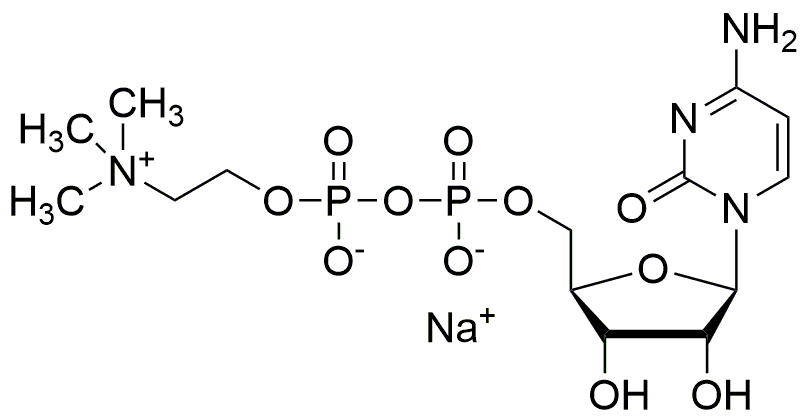Cytidine 5'-diphosphocholine sodium salt is widely utilized in research focused on:
- Neuroscience Research: This compound is often used to study neuronal signaling and membrane dynamics, helping researchers understand the role of phospholipids in brain function.
- Pharmaceutical Development: It serves as a key ingredient in formulations aimed at enhancing cognitive function and memory, making it valuable in the development of nootropic drugs.
- Cell Culture Applications: Cytidine 5'-diphosphocholine sodium salt is used in cell culture media to promote cell growth and differentiation, particularly in neuronal cell lines.
- Cardiovascular Studies: Researchers utilize this compound to investigate its effects on lipid metabolism and its potential protective roles in cardiovascular health.
- Biochemical Assays: It is employed in various biochemical assays to measure enzyme activity related to phospholipid metabolism, providing insights into cellular processes.
General Information
Properties
Safety and Regulations
Applications
Cytidine 5'-diphosphocholine sodium salt is widely utilized in research focused on:
- Neuroscience Research: This compound is often used to study neuronal signaling and membrane dynamics, helping researchers understand the role of phospholipids in brain function.
- Pharmaceutical Development: It serves as a key ingredient in formulations aimed at enhancing cognitive function and memory, making it valuable in the development of nootropic drugs.
- Cell Culture Applications: Cytidine 5'-diphosphocholine sodium salt is used in cell culture media to promote cell growth and differentiation, particularly in neuronal cell lines.
- Cardiovascular Studies: Researchers utilize this compound to investigate its effects on lipid metabolism and its potential protective roles in cardiovascular health.
- Biochemical Assays: It is employed in various biochemical assays to measure enzyme activity related to phospholipid metabolism, providing insights into cellular processes.
Documents
Safety Data Sheets (SDS)
The SDS provides comprehensive safety information on handling, storage, and disposal of the product.
Product Specification (PS)
The PS provides a comprehensive breakdown of the product’s properties, including chemical composition, physical state, purity, and storage requirements. It also details acceptable quality ranges and the product's intended applications.
Certificates of Analysis (COA)
Search for Certificates of Analysis (COA) by entering the products Lot Number. Lot and Batch Numbers can be found on a product’s label following the words ‘Lot’ or ‘Batch’.
*Catalog Number
*Lot Number
Certificates Of Origin (COO)
This COO confirms the country where the product was manufactured, and also details the materials and components used in it and whether it is derived from natural, synthetic, or other specific sources. This certificate may be required for customs, trade, and regulatory compliance.
*Catalog Number
*Lot Number
Safety Data Sheets (SDS)
The SDS provides comprehensive safety information on handling, storage, and disposal of the product.
DownloadProduct Specification (PS)
The PS provides a comprehensive breakdown of the product’s properties, including chemical composition, physical state, purity, and storage requirements. It also details acceptable quality ranges and the product's intended applications.
DownloadCertificates of Analysis (COA)
Search for Certificates of Analysis (COA) by entering the products Lot Number. Lot and Batch Numbers can be found on a product’s label following the words ‘Lot’ or ‘Batch’.
*Catalog Number
*Lot Number
Certificates Of Origin (COO)
This COO confirms the country where the product was manufactured, and also details the materials and components used in it and whether it is derived from natural, synthetic, or other specific sources. This certificate may be required for customs, trade, and regulatory compliance.


